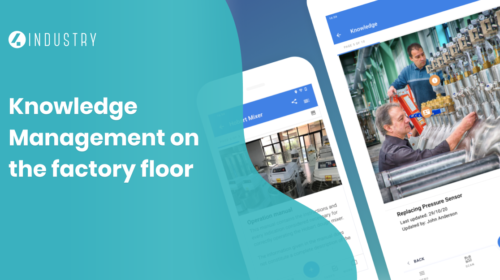
Everything you need to know about Mean Time to Repair (MTTR) in manufacturing
Read up on everything you need to know about mean time to repair (MTTR).

What is Mean Time to Repair (MTTR)?
Mean time to repair (MTTR) is a key equipment maintenance metric that expresses the average amount of time it takes to fully fix unplanned breakdowns.
In this glossary article, you’ll find everything you need to know about MTTR in manufacturing. We’ll start by covering the basics: how you calculate MTTR, what it’s used for, and so on. Further on in the article, we’ll go a little more in depth and discuss the best ways in which you can reduce your MTTR.
Let’s get started!
How to calculate MTTR
Calculating MTTR luckily doesn’t require you to know advanced mathematics: you simply divide the total amount of maintenance time spent on a piece of equipment over a certain period by the total amount of incidents. Here’s a quick calculation to make that a little more concrete.
Let’s take a machine that broke down five times over a year. The total time spent on repairs was 43 hours. Simply divide the latter number by the former and, voila: the MTTR for that piece of equipment is 8.6 hours.

What is a good MTTR?
It is difficult to answer this question definitively, as what constitutes good MTTR is naturally not the same for every machine. If you want to know the average MTTR of your machines, it’s best to compare it to industry benchmarks. This allows you to set realistic MTTR improvement goals and prevents you from setting the bar too high (or low!).
What is MTTR used for in manufacturing?
MTTR is a very useful metric in manufacturing; it is an important indicator of a factory’s effectiveness at responding to unplanned breakdowns. Breakdowns lead to downtime, and downtime leads to loss of productivity, output, revenue and so on. MTTR data can therefore be of great assistance in finding ways to boost productivity and increase OEE. MTTR data is, however, not a solution to improving maintenance effectivity in itself.
Let’s dig into the limitations of MTTR.
The limitations of MTTR
MTTR’s main limitation lies in its metrical nature; it is in itself not a solution to maintenance problems, but an indicator that can lead to an investigation into the root causes of ineffective maintenance processes.
The downside of MTTR is that doesn’t give you any information on the specific nature of breakdowns. Let’s say you’ve done an MTTR analysis on a group of five ovens in your factory. If one of them broke down for an extended amount of time (for whatever reason), your MTTR data will present you with a distorted view of reality, as the other ones might have decent or even good MTTR.
It’s therefore important to not take your MTTR data at face value. You should carefully investigate individual breakdowns before you take action. You don’t want to go about effecting maintenance improvements haphazardly, as the root cause might lie in an unexpected corner.
How to reduce MTTR
To those of you who already know 4Industry, our solution to reducing MTTR should be easy to guess: going digital. The following paragraphs should, however, not be interpreted as a plea for digitalization in general or switching over to a connected worker platform (CWP) in particular. Although implementing a platform with standardized digital checklists and SOPs has tremendous benefits, you can always fall back on paper if necessary.
Notifications
When a breakdown occurs, maintenance personnel should be alerted as soon as possible. Luckily, there are ways of automating this process. Wireless sensors can notice when a breakdown occurs and alert the relevant employees, who can immediately come into action.
Checklists and SOPs
Standardized, accurate checklists and SOPs will greatly reduce the time it takes your maintenance people to fix a breakdown. Proper checklists give perspective on the precise things that can go wrong with a piece of equipment. Good SOPs, meanwhile, ensure that repairs are smooth and straightforward.
Curious as to what you can do to create future-proof digital SOPs? In this blog, we explore the subject in more detail.
Conclusion
MTTR is a valuable metric for gaining perspective on your plant’s maintenance effectiveness. Maintenance managers often use it as a baseline metric for more thoroughgoing investigations. It does, however, carry limitations, and it is important to be aware of these. Installing sensors to notify your personnel when breakdowns occur and setting up high-quality checklists and SOPs can be of great help in reducing MTTR.
Want to stay up to date with everything Industry 4.0? Connect with us on LinkedIn to find out about our latest blogs, whitepapers, reports and much more!
Curious about the manufacturing trends that are shaping the future?

Related Articles

Knowledge Management on the factory floor

Work on tasks from an easy-to-use Task Management system

